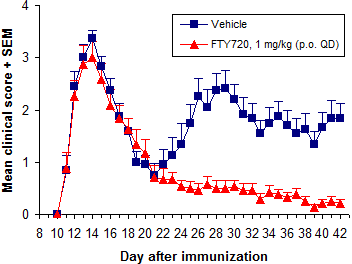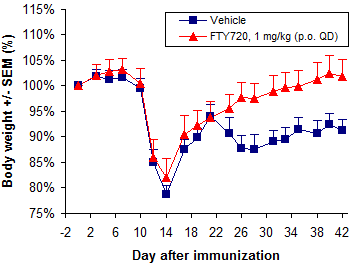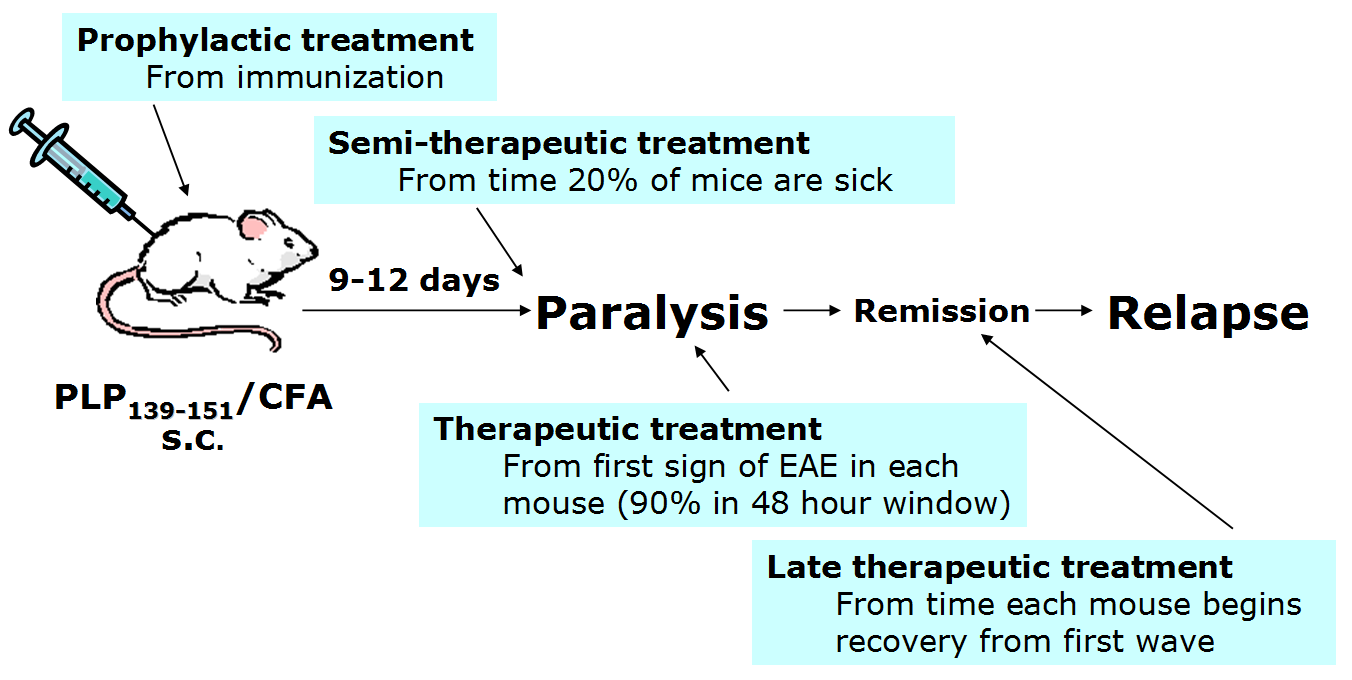[Ser140]-PLP139-151/CFA-Induced Relapsing-Remitting EAE in SJL Mice
Hooke runs most commonly-used EAE models. Click here for an overview of EAE and a list of models offered.
Relapsing-remitting MS is the most common form of multiple sclerosis (MS) in human patients. This form of disease is most closely modeled by EAE induced by [Ser140]-PLP139-151/CFA in SJL mice, making it the best model for study of compound effects on EAE relapses. This model also exhibits highly synchronized EAE onset.
Usually this model is used with therapeutic treatment, to study development of EAE relapses. Therapeutic studies are typically run for 5 to 7 weeks, but mice are sometimes observed longer.
Please contact Hooke at or with questions or for a quotation.
Typical results in this model
Late therapeutic treatment (from Day 20 after immunization)


| Treatment | Median day of onset |
MMS ± SEM |
End score ± SEM |
p value |
Relapse incidence | p value |
End weight (%) ± SEM |
p value |
|---|---|---|---|---|---|---|---|---|
| Vehicle | 11.5 | 3.42 ± 0.14 | 1.83 ± 0.30 | 83% | 91.2 ± 2.2 | |||
| FTY720 | 11.5 | 3.33 ± 0.13 | 0.21 ± 0.07 | 0.0003 | 0% | <0.0001 | 101.8 ± 3.3 | 0.0122 |
Disease development
This direct EAE model is induced by immunization with [Ser140]-PLP139-151 emulsified in CFA, optionally followed by administration of pertussis toxin (PTX). With or without PTX, EAE normally develops in more than 90% of mice.
Without PTX administration, most mice recover from the first wave of EAE and 50 to 80% of those will relapse.
Administration of PTX reduces the relapse rate to as low as 20%, but disease onset is earlier, severity of the first wave of paralysis is greater, and recovery from the first wave is slower.
Direct EAE induction in SJL mice

Like most MS patients, most mice will recover from the first wave of paralysis (remission). While the first wave is very uniform among all mice, each individual mouse will have a different course of EAE after that.
Each wave of paralysis results in weight loss at onset, most of which is regained in remission. Weight loss is greatest during the first wave. After that, average (group) weight is relatively stable because relapses are unsynchronized, so only a few mice in each group are acutely sick at any given time.
Treatment regimens
This model can be used with any of the standard EAE treatment regimens, but is most often used with therapeutic or late therapeutic treatment.
Prophylactic treatment
In prophylactic treatment mice are treated from the time of immunization and are usually followed for 3 weeks. The first EAE wave is short and most mice fully recover, resulting in a small treatment window.
Usually pertussis toxin is administered after immunization to generate more severe EAE and a larger treatment window. Disease severity during the initial wave of disease is the main readout, and relapse development is usually not analyzed because of the low relapse rate.
Semi-therapeutic treatment
All mice begin treatment when the first mice develop signs of EAE (while the remainder are still disease-free).
This treatment regimen is rarely used because EAE onset is highly synchronized in this model; 80 to 90% of mice develop EAE within a 48 hour period. This gives very little time for treatment before disease onset, and results in groups that are not as well balanced as in therapeutic treatment, because most mice are assigned randomly (instead of balancing for EAE severity at onset).
Therapeutic treatment
Therapeutic treatment specifically demonstrates whether a compound will reverse the course of disease and/or improve recovery. In therapeutic treatment mice are usually enrolled into treatment groups one at a time, at EAE onset for each mouse. Groups are balanced for similar time of EAE onset and severity at enrollment - this gives very uniform groups and makes the model more sensitive to compound efficacy. We often recommend this stringent treatment regimen as a follow-up to prophylactic studies, to establish compound efficacy after disease onset.
Mice are usually followed for 5 to 7 weeks after immunization.
The most important result in therapeutic treatment is the reduction in incidence of relapses and mean maximum score during the relapse period (period from the time of relapse onset in the vehicle-treated group to the end of the study).
Late therapeutic treatment
Late therapeutic treatment (starting at recovery from the first wave of EAE) is useful for specifically evaluating the effect of drugs on relapses without treatment during the initial wave of disease. In addition to day of EAE onset and score at enrollment, groups are also balanced for score at the first peak of disease.
FTY720 (fingolimod, Gilenya), usually used as a positive control, almost completely suppresses EAE relapses in late therapeutic treatment.
Tissue collection and end-of-study analysis
Hooke offers an extensive set of tissue collection and analysis options. Click here for more information.


_150px.jpg)